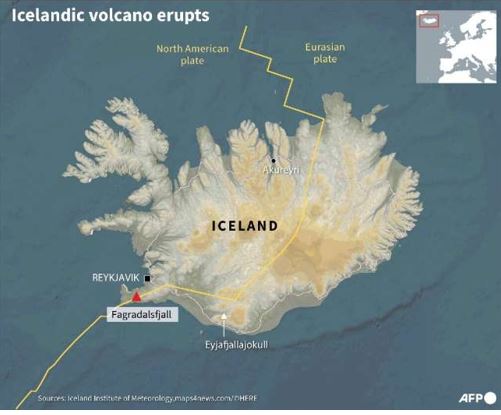

22th December 2023 (10 Topics)
Context
Iceland is one of the most volcanically active regions on the planet. It witnesses an eruption every four to five years. However, since 2021, the frequency has spiked to almost one eruption per year.
Volcanic Activity in Iceland: Fagradalsfjall Eruption
- Location and Background
- Fagradalsfjall, situated on the Reykjanes peninsula in southwest Iceland, erupted on December 18.
- Preceded by weeks of intense earthquakes and tremors.
- The volcano, dormant for over 6,000 years, became active in March 2021.
- Lava Flow Dynamics
- Initial eruption witnessed hundreds of cubic meters of lava per second.
- Authorities on alert for potential new vents opening at short notice.
Impact and Evacuations
- Evacuation Measures
- Authorities anticipated the eruption due to seismic activity.
- Nearly 4,000 people evacuated from Grindavik, a threatened fishing town.
- No reports of injuries, but some houses damaged.
- Frequent Eruptions
- Third eruption in the past two years at Fagradalsfjall.
- Iceland's volcanic activity has surged since 2021, with nearly one eruption per year.
Understanding Volcanoes
- Volcanic Definition
- According to the US Geological Survey, volcanoes are vents where lava, tephra, and steam erupt onto Earth's surface.
- Formation Mechanisms
- Magma rises through tectonic plate movements (divergent and convergent).
- Hotspots inside the Earth contribute to magma rising.
|
Types of Volcanoes:
|
Iceland's Volcanic Activity Explained
- Geological Location
- Iceland sits on the Mid-Atlantic Ridge, where Eurasian and North American plates move apart.
- Volcanic rift zones result from the Earth's crust being pulled apart.
- Hotspot Influence
- Iceland's position over a hotspot contributes to enhanced volcanic activity.
- Hot zones lead to the rise of magma, resulting in eruptions.
Way Forward:
- High Dynamicity: The Fagradalsfjall eruption highlights the dynamic nature of Iceland's volcanic landscape.
- Tectonic interaction: Frequent eruptions and the interaction of tectonic plates make the region a hotbed of geological activity.
- Volcano Management: Understanding these phenomena is crucial for both scientific research and implementing effective evacuation and mitigation strategies to safeguard the population living in the shadow of these powerful natural forces.




